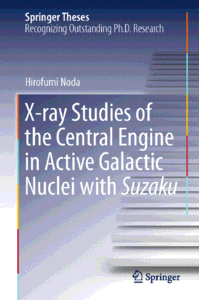X-ray Studies of the Central Engine in Active Galactic Nuclei with Suzaku
Springer | Physics | January 8, 2016 | ISBN-10: 9812877207 | 153 pages | pdf | 9.5 mb
Springer | Physics | January 8, 2016 | ISBN-10: 9812877207 | 153 pages | pdf | 9.5 mb
by Hirofumi Noda (Author)
Nominated as an outstanding contribution by The University of Tokyo's Department of Astronomy in 2013
Presents a technique for variability-assisted spectral decomposition of X-ray components generated in an active galactic nucleus
Proposes a novel picture of the central engine, formed by multiple coronae and an accretion disk onto a supermassive black hole, in an active galactic nucleus
From the Back Cover
The aim of this research was to use the X-ray satellite Suzaku to establish a picture of a central engine that effectively converts the gravitational energy of accreting matter onto the supermassive black hole to a huge amount of radiation in an active galactic nucleus. Although the engine is known to consist of a Comptonizing corona and an accretion disk, its image has remained unclear because primary emissions, coming directly from the engine, cannot be identified in X-ray spectra without models. The book describes a technique of time variability assisted spectral decomposition to model-independently examine X-ray signals, and how this was applied to the Suzaku archive data of active galactic nuclei. As a result, at least three distinct primary X-ray components have been discovered in an X-ray from an active galactic nucleus, presumably indicating a novel picture that the engine is composed of multiple coronae with different physical properties in an accretion flow. Furthermore, the determination of the spectral shapes of the primary X-rays has a significant impact on estimations of black hole spins, because it is essential to quantify reprocessed X-ray spectra. The successful model-independent decomposition of X-ray spectral components with flux variations of active galactic nuclei is likely to be effective in future data analyses from the soon-to-be-launched Japanese X-ray satellite ASTRO-H, which is capable of achieving unprecedented fine spectros
copy and broad energy band coverage.
About the Author
Dr. Hirofumi Noda
Department of Astronomy, The University of Tokyo
More info and Hardcover at Springer
Donate to Support :)



